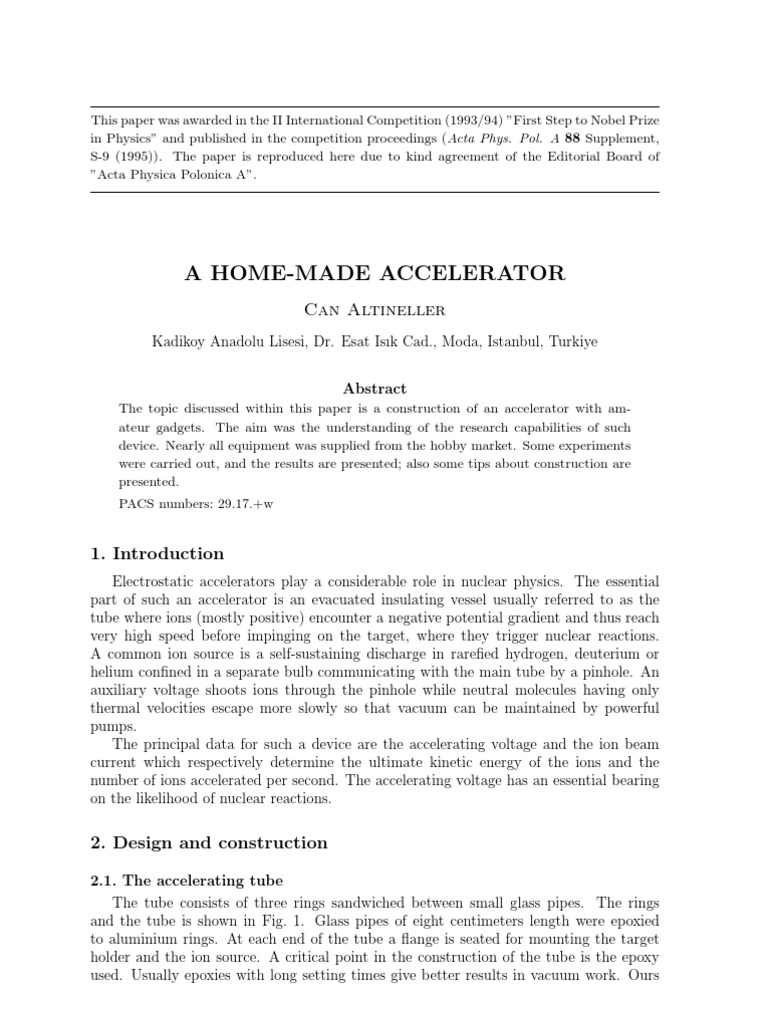The allure of particle accelerators captivates not only physicists but also curious minds across various disciplines. These magnificent machines, often regarded as the gateway to understanding the fundamental components of the universe, facilitate the manipulation of subatomic particles at unprecedented energies. They unveil the mysteries underlying the fabric of matter and the forces governing the cosmos. In this exploration, we delve into the essential steps and considerations involved in constructing a particle accelerator.
1. Understanding the Fundamentals
Before embarking on the journey to build a particle accelerator, it is imperative to comprehend the underlying principles. At its core, a particle accelerator propels charged particles, such as electrons or protons, to relativistic speeds. This process typically involves two fundamental components: electric fields, which accelerate the particles, and magnetic fields, which steer them along a designated path. Understanding electromagnetic theory, quantum mechanics, and relativity is essential for anyone keen on engineering such a complex apparatus.
2. Choosing the Type of Particle Accelerator
Particle accelerators primarily fall into two categories: linear accelerators (linacs) and circular accelerators (synchrotrons). A linear accelerator propels particles along a straight trajectory, while a synchrotron accelerates particles along a circular path, utilizing magnetic fields to confine and focus them. The choice between these types is influenced by the intended application, such as radiation therapy, collider experiments, or materials research. A thorough understanding of these distinctions will guide the design process and ensure the chosen configuration aligns with the overarching scientific objectives.
3. Designing the Accelerator
The design phase is a crucial juncture in the construction of a particle accelerator. Engineers and physicists must collaborate to develop a blueprint that optimally integrates the accelerator’s various components. Critical considerations include the length of the accelerator, the desired energy levels, and the nature of the particles to be accelerated. Computational modeling and simulations play an integral role at this stage, allowing for the assessment of magnetic field configurations and electromagnetic compatibility.
4. Essential Components
Once the design is established, the configuration of essential components must be meticulously planned. These components include:
- Electron Gun: A device that generates and injects electrons into the accelerator. It employs thermionic emission or field emission to produce a reliable and stable electron beam.
- Radiofrequency (RF) Cavities: These structures house oscillating electric fields, imparting energy to the particles while they traverse through the cavities, thereby increasing their speed.
- Magnetic Structures: Dipole magnets are essential for bending the particle trajectory, while quadrupole magnets focus the beam. The precision of these magnetic components directly affects the stability and brightness of the particle beam.
- Vacuum System: To minimize particle collisions with air molecules, a high-vacuum system must be established. Achieving and maintaining this vacuum is essential for optimizing the performance of the accelerator.
- Detection Systems: Incorporating sophisticated detectors enables the observation and analysis of particle collisions. These systems play a pivotal role in extracting meaningful data from experimental runs.
5. Construction and Assembly
The actual construction of the particle accelerator represents a significant engineering challenge. Precision is paramount; even minor deviations in alignment or configuration can severely impact performance. Components must be manufactured to exacting standards, often utilizing advanced materials that can withstand the extreme conditions within the accelerator. Assembly involves intricate procedures, including aligning magnetic fields, installing RF cavities, and integrating the vacuum system. This step requires multidisciplinary collaboration, merging expertise from physics, engineering, and materials science.
6. Testing and Calibration
Upon completion of the construction phase, rigorous testing and calibration procedures must be performed. Initially, low-energy tests ascertain that components operate as intended. Once verified, a series of incremental tests involving higher energy levels ensue. Calibration of magnetic fields and RF frequencies is crucial to avoid beam instabilities during full operation. Monitoring systems are employed to ensure real-time adjustments can be made to maintain optimal conditions.
7. Operational Considerations
Once the accelerator is operational, ongoing maintenance and monitoring are essential for sustained performance. Regular maintenance routines minimize downtime and enhance the longevity of components. Precision in operational parameters, such as beam intensity and vacuum quality, must be meticulously analyzed. Collaboration with researchers and scientists becomes vital to ensure the accelerator meets the evolving demands of experimental physics.
8. Safety Measures
Given the high-energy collisions and radiation produced by particle accelerators, implementing robust safety measures is non-negotiable. Shielding, interlocks, and emergency shutdown mechanisms must be integrated into the design. Personnel training on safety protocols and emergency response is also essential to foster a secure operational environment.
In conclusion, the construction of a particle accelerator represents not merely a feat of engineering but a profound journey into the realms of fundamental physics. This intricate endeavor demands a harmonious collaboration across various scientific disciplines, embodying the essence of inquiry that drives our quest for knowledge about the cosmos. As our understanding deepens, these astounding machines will continue to unveil the enigmatic characteristics of matter and energy, perpetually igniting curiosity and fascination in the scientific community and beyond.












